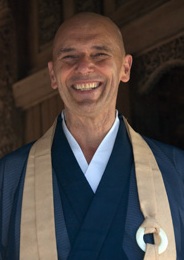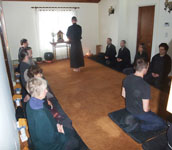Meditations on Meditation: A Visit to a Zen Centre
 This past Sunday, I went to the Zen Centre of Vancouver to do their introductory session to Zen. I’ve been meditating regularly for years, using more or less the same methods as they do in Zen. I recently decided that it might be nice to try formal practice in a group to see what it’s like. It was an interesting experience that I’d like to share.
This past Sunday, I went to the Zen Centre of Vancouver to do their introductory session to Zen. I’ve been meditating regularly for years, using more or less the same methods as they do in Zen. I recently decided that it might be nice to try formal practice in a group to see what it’s like. It was an interesting experience that I’d like to share.
I rode my scooter to the Zen Centre early Sunday morning. At first, I drove past it. It was easy to miss being a house in a residential area with only a humble sign over the front door marking it for what it was (as seen here on the right before it was renovated). I rang the doorbell and was greeted by Eshin John Godfrey (shown in photo below on the left), the centre’s abbot. He is a friendly man who smiles a lot, and does a great job of making new visitors feel comfortable and welcome as I came to discover.
The house itself has been beautifully renovated and decorated for its use as a Zen centre. It has a wide entry area with plenty of shoe and coat storage for visitors. The main meditation room has plenty of natural light and a simple but lovely shrine at the head. They also have a nice sitting area where members gather to meet and talk about their experiences at the centre or just their day-to-day lives. After meeting a few of the Zen centre’s members, they congregated in the meditation room while I was escorted into a private office with Eshin.
An Introduction to Zen
 Eshin spent about 30 minutes discussing Zen, asking about my own meditation experience and impressions of Zen, as well as what I expect from it. We then settled onto the zafu and zabuton (meditation cushions) in the office and he verbally guided me through 25 minutes of “sitting” (how they generally refer to the practice of meditation at the Zen Centre). He spoke of being present as we sit, paying attention to all the subtle sounds in of the house, as well as the sensations in my own body as I breathed in and out. After sitting, we stood up and he led me through kinhin (walking meditation), in which we walk slowly in a circle, keeping consistent pace with the person ahead of us. This practice reminds me a lot of Taichi style movement in which you try to go slowly but not stop moving. It’s also a nice way to stretch the legs after sitting in lotus for extended periods.
Eshin spent about 30 minutes discussing Zen, asking about my own meditation experience and impressions of Zen, as well as what I expect from it. We then settled onto the zafu and zabuton (meditation cushions) in the office and he verbally guided me through 25 minutes of “sitting” (how they generally refer to the practice of meditation at the Zen Centre). He spoke of being present as we sit, paying attention to all the subtle sounds in of the house, as well as the sensations in my own body as I breathed in and out. After sitting, we stood up and he led me through kinhin (walking meditation), in which we walk slowly in a circle, keeping consistent pace with the person ahead of us. This practice reminds me a lot of Taichi style movement in which you try to go slowly but not stop moving. It’s also a nice way to stretch the legs after sitting in lotus for extended periods.
Our Thoughts Are Not the Enemy
Eshin talked about how our thoughts are not the enemy when we sit. Of course, we are trying to be present in the moment, but in doing so, “all the junk” we have in our heads and hearts will rise to the surface, and when that happens we simply allow it, accept it and let it go. He mentioned that when he first started meditating he found a lot of feelings of anger rising to the surface, which surprised him because he had never thought of himself as being a particularly angry person. But it was something that had settled deep within him and the practice of Zen allowed him to uncover it and let it go.
I found this idea very interesting. Everyone has a lot of “mental junk”, conscious or subconscious, that often gets in the way of the things we want in life, productivity at work, excellence in the things we do, healthy, happy relationships, etc. When I “sit”, I find that when thoughts arise, they are often related to the things I want to accomplish in life, about my value as a person. My attachments in life come to light. During my private sitting session in the office, I thought about how it pleased me that Eshin told me that I have good sitting form. I thought about how meditation might help me be a better martial artist. To the average person, these thoughts may not seem like such a bad thing, but ultimately if you’re thinking about these attachments from past experiences or for future development, you’re not really fully present in the moment. But that’s not necessarily a bad thing, as Eshin pointed out.
Eshin told me that we have to let these thoughts come up rather than suppressing them, which makes sense to me. After all, you have to take out the trash first before you can enjoy a clutter-free home. But you don’t want to become consumed with your focus on the trash nor identify yourself with the thoughts that bubble to the surface as you become still. Eshin said that when he found angry thoughts coming up, it would not have benefited him if he had simply concluded that he must be an “angry person.” The thoughts that come up may be a part of your present experience but they are not ultimately “who you are.” Eshin told me that from what he knows of me, I need to focus on the out-breath aspect of meditation. The in-breath fills us with the energy and connectivity of the universe, while the out-breath allows us to release our inner tensions, conflicts and attachments. Knowing the thoughts I experience during sitting sessions, this makes sense to me.
Ironically, if I want to get the most out of my sitting time, I would best be served by letting go of my desire to “do it well” or to become a better martial artist through my meditation. If it sounds like the sort of advice that would come from Yoda or Morpheus, you’re right. In fact, Zen is very much an influence on those pop culture icons. It is also very much an influence on the martial arts. If you’re thinking about what you’re doing in a fight, whether it’s in self-defense or in competition, you’re probably two steps behind where you want to be. Our attachments to results by way of thought often prevents us from achieving the very results that seek.
Joining the Group Meditation Session
 After our private session, I joined the others in the main hall doing the group session. Together, we did two 25-minute sits and two 5-minute kinhin, followed by a chanting of sutras. The chanting was a new experience for me, which Eshin ushered in by explaining that while we do chant Buddhist sutras, the words that are said really don’t matter. I don’t remember exactly how he explained it, but it was something along the lines of it being more about experiencing our connection to the universe through the vibrations of sound. I like this explanation as it clarified its purpose for me, which I didn’t know in the past. Zen chanting could easily be seen as simply a form of prayer or worship, which isn’t really the intent behind it.
After our private session, I joined the others in the main hall doing the group session. Together, we did two 25-minute sits and two 5-minute kinhin, followed by a chanting of sutras. The chanting was a new experience for me, which Eshin ushered in by explaining that while we do chant Buddhist sutras, the words that are said really don’t matter. I don’t remember exactly how he explained it, but it was something along the lines of it being more about experiencing our connection to the universe through the vibrations of sound. I like this explanation as it clarified its purpose for me, which I didn’t know in the past. Zen chanting could easily be seen as simply a form of prayer or worship, which isn’t really the intent behind it.
After the chanting, we were offered tea as part of the practice. Eshin didn’t go into any detail about this practice other than what to expect, but my impression is that is an act of sharing amongst the group, one in which we experience receiving tea through our senses, much like the thought behind Japanese tea ceremony, though much less elaborate. When the formal session was finished, we all participated in the samu or ‘work practise’ (meaning ‘to do one’s obligations’ like cleaning, gardening, repair, etc) for the Zen Centre (performed after sitting sessions every Sat and Sun), which was followed by a less formal, more social setting in which we drank tea and enjoyed snacks together. Knowing about my martial arts background, much of the conversation revolved around Zen and the martial arts, which is always enjoyable for me.
There are many people who expound the benefits of group meditation, from a sense of connectedness to the far-reaching affects of unifying the group’s positive intentions to influence a larger group of people. After only a single group session, I can’t really speak of either of these benefits. I wish I could say that I had had some profound awakening in that hour I spent with the group, but that wasn’t the case. That being said, I did enjoy the experience. Since my introductory session fee includes my first month of membership at the Zen Centre, I’ll go in again for more sessions to see if it’s something I’ll want to keep doing on a regular basis.
Have you ever tried formal meditation in a group setting? Please share your thoughts on your experiences with it in the comments. 🙂

 We're proud to announce that Lori O'Connell Sensei's new book, When the Fight Goes to the Ground: Jiu-jitsu Strategies & Tactics for Self-Defense, published through international martial arts publisher Tuttle Publishing, is now available in major book stores and online. More about it & where to buy it.
We're proud to announce that Lori O'Connell Sensei's new book, When the Fight Goes to the Ground: Jiu-jitsu Strategies & Tactics for Self-Defense, published through international martial arts publisher Tuttle Publishing, is now available in major book stores and online. More about it & where to buy it.
Great article. Nice read and sounds like a place I would like to visit one day 🙂
Perhaps the next time you come to Vancouver? 🙂